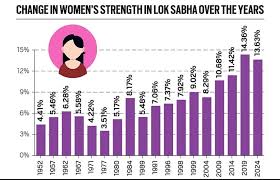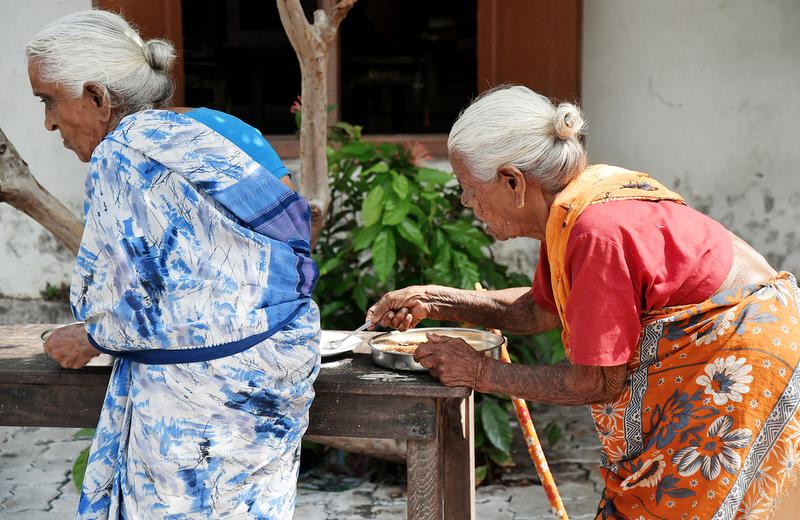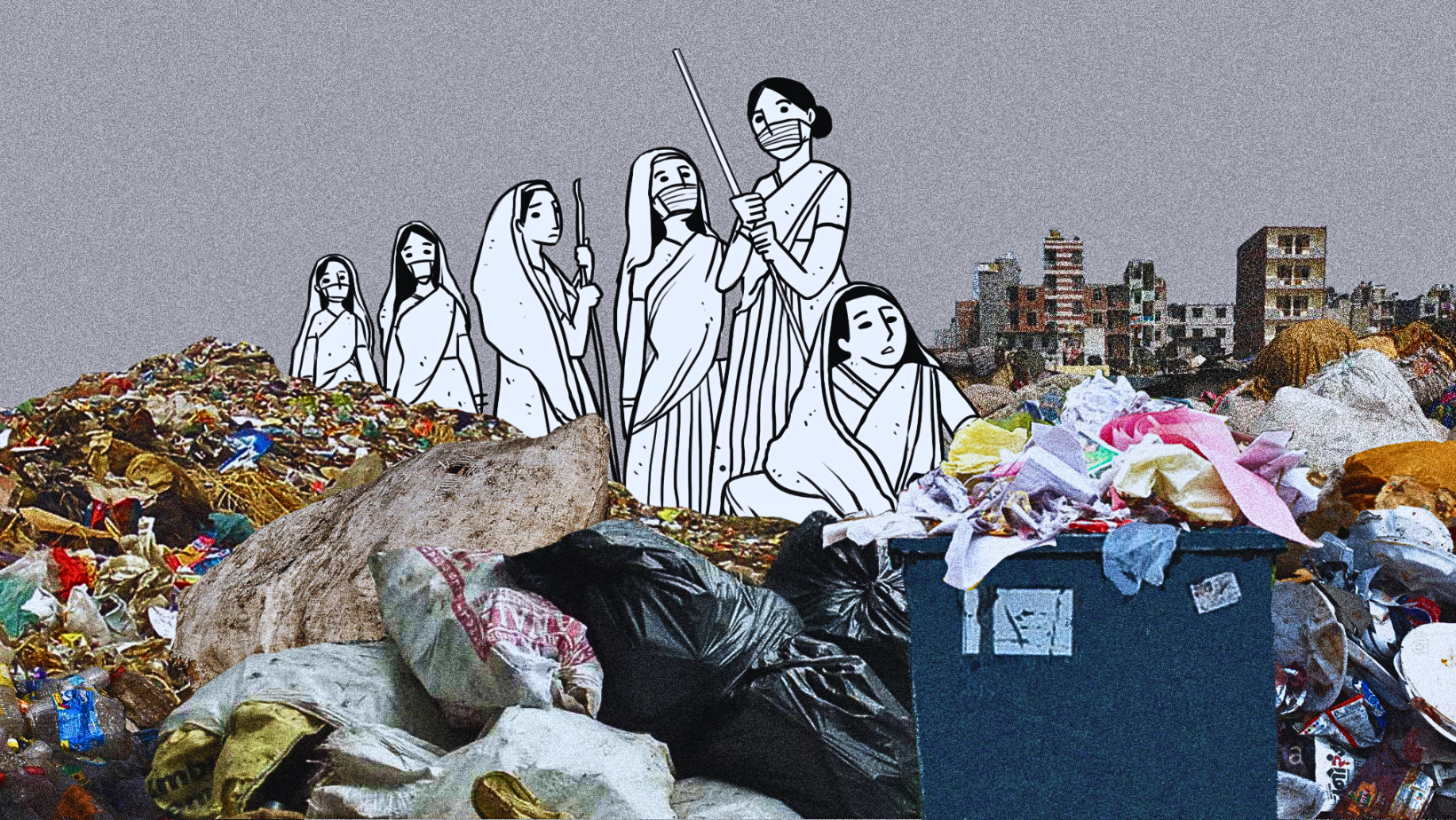The Need for More Women in Politics

- 15 Nov 2024
In News:
India, the world's largest democracy, is at a crucial juncture where women’s active political participation is essential for holistic development and true democratic engagement. The year 2024 demands increased involvement of women in politics to address issues of gender inequality and ensure comprehensive policy representation.
Current Status of Women’s Political Representation in India
Women in Parliament
- Initial Representation: In 1952, women accounted for only 4.41% of the Lok Sabha. This gradually rose to around 14.36% in the 2019 elections.
- Recent Trends: In the 2024 elections, women made up approximately 16% of the Lok Sabha, with 74 women MPs, 43 of whom are first-time representatives.
Women in State Legislatures
- Representation in state legislative assemblies remains low, with the highest percentages in Chhattisgarh (14.4%), West Bengal (13.7%), and Jharkhand (12.4%).
Global Comparison
- According to the Inter-Parliamentary Union (IPU), India ranks lower than many countries in terms of female representation in parliament, with global averages standing at 26.1%. India lags behind several African and South Asian nations.
Importance of Women’s Political Empowerment
- Enhancing Governance and Accountability: Political empowerment of women ensures better representation of gender-sensitive issues, promoting accountability in governance.
- Breaking Patriarchal Norms: Increasing women’s participation helps challenge the patriarchal structure that dominates Indian politics and promotes inclusive governance.
- Policy and Social Impact: Women in politics are more likely to advocate for policies that address issues like health, education, and gender equality, leading to improved societal welfare.
- Economic Benefits: Studies suggest that women in political leadership tend to improve economic outcomes for their constituencies by prioritizing social infrastructure.
Barriers to Women’s Political Participation
- Gender Gaps in Political Ambition: Women are less likely to pursue political careers due to gender conditioning, family pressures, and stereotypes about leadership abilities.
- Patriarchal Culture: A deeply ingrained patriarchal society hampers women’s political involvement, with male-dominated party structures and social norms limiting opportunities.
- High Election Costs: The financial burden of running for office often discourages women from contesting elections due to unequal access to resources.
- Male Gatekeepers in Politics: Political parties often show a preference for male candidates, especially for higher-profile positions, hindering the rise of women leaders.
- Criminalisation and Corruption in Politics: Growing criminalisation in politics and lack of political education further alienates women from the political process.
Key Legislative and Constitutional Measures for Women’s Political Empowerment
Legislative Measures
- Nari Shakti VandanAdhiniyam (2023): Provides 33% reservation for women in the Lok Sabha and state assemblies.
- 73rd and 74th Amendments (1992): Introduced 33% reservation for women in Panchayats and Municipalities.
- Gender-Neutral Rules: Lok Sabha adopted gender-neutral rules in 2014, promoting inclusivity in legislative procedures.
Constitutional Provisions
- Article 14 and 15: Ensure equality and non-discrimination, fundamental to women’s political participation.
- Article 243D: Mandates 33% reservation for women in Panchayats.
International Commitments
- CEDAW (1979): Advocates for women’s participation in political and public life.
- Beijing Platform (1995) and SDGs (2015): Call for removing barriers to women’s participation in politics.
Measures for Promoting Women’s Political Participation
- Quotas and Reservations: Ensuring mandatory quotas for women candidates in party tickets and legislative bodies can help bridge gender gaps.
- Capacity Building and Training: Offering political training programs for women can empower them with the skills and resources necessary for effective political participation.
- Strengthening Grassroots Movements: Support for Self-Help Groups (SHGs) and Panchayati Raj Institutions (PRIs) can build leadership among women at the local level.
- Supportive Political Ecosystem: Political parties should be encouraged to nominate women for higher office positions, such as the Rajya Sabha or state legislative councils.
- Raising Public Awareness: Public awareness campaigns focusing on the importance of women in politics can shift societal attitudes and garner wider public support.
Conclusion:
As India moves forward, the active participation of women in politics is not merely a matter of equity but an essential building block for a vibrant, inclusive, and effective democracy. Through structural reforms, public awareness, and the promotion of female leadership, India can strengthen its democratic framework, ensuring that all citizens, regardless of gender, have an equal stake in shaping the nation's future.
What are the costs of population decline?

- 11 Nov 2024
In News:
India has been witnessing significant demographic changes due to decades of family planning policies. This has led to declining fertility rates in certain States, particularly in the southern and smaller northern regions.
Introduction: Demographic Shift in India
- Southern States’ Fertility Trends: States like Tamil Nadu, Kerala, Andhra Pradesh, and Telangana have fertility rates below the replacement level (around 1.4–1.5), while Bihar, Uttar Pradesh, and Madhya Pradesh have higher fertility rates (2.6–3).
- Ageing Population: Southern States face the challenge of an ageing population, with Kerala projected to have 22.8% of its population aged 60+ by 2036, while Bihar will have only 11%.
Economic and Health Impact of Population Decline
- Economic Consequences:
- Dependency Ratio: The old-age dependency ratio (the number of elderly for every 100 working-age individuals) has increased significantly in some States. Kerala, for example, had a ratio of 26.1 in 2021, signaling a crisis point.
- Loss of Demographic Dividend: States with declining fertility rates face the loss of a demographic dividend, i.e., the economic benefit from a large working-age population, which is increasingly burdened by elderly dependents.
- Health Expenditure: Rising healthcare costs, especially for cardiovascular diseases in southern States, will strain public health systems. The southern States, although comprising one-fifth of India's population, spent 32% of the country’s total out-of-pocket expenditure on cardiovascular diseases in 2017-18.
- Challenges of Low Fertility:
- Declining Labour Force Participation: Policies encouraging higher fertility may also reduce women’s labour force participation, undermining the economic growth of these States.
- Economic Pressures: Southern States, despite higher tax contributions, face a diminished share of central resources due to slower population growth. This is a point of concern in inter-State fiscal relations.
Political Implications of Uneven Population Growth
- Impact on Federal Structure:
- The uneven population growth across States will lead to significant changes in the delimitation of constituencies after the current freeze on seat allocation in Parliament expires in 2026.
- Redistribution of Lok Sabha Seats: Northern States like Uttar Pradesh and Bihar will likely gain more seats, while southern States like Tamil Nadu, Kerala, and Andhra Pradesh will lose seats due to their declining population shares.
- Challenges in Federal Relations:
- Southern States’ economic contributions through taxes are disproportionate to the resources they receive from the central pool, leading to growing tensions between high-growth and slow-growth regions.
- The shift in political power post-delimitation could increase regional disparities, potentially leading to political tensions between States.
Solutions and Policy Recommendations
- Pro-Natalist Policies:
- Southern States are considering pro-natalist policies to incentivize higher fertility rates. However, such measures have been largely unsuccessful internationally, especially when women’s economic independence and educational choices are restricted.
- International Experience: Attempts to incentivize childbearing, without addressing broader socio-economic factors like gender equality, have generally failed in other nations. Maternity benefits, gender-neutral parental leave, and childcare support are key to increasing fertility sustainably.
- Gender Equity and Work-Family Balance:
- Work-family policies that support paid maternity and paternity leaves, affordable childcare, and gender-neutral employment policies are essential to empower women to balance family and career.
- Studies indicate that countries with higher gender equity have better fertility rates because women are less likely to forgo childbearing for career reasons.
- Increasing Retirement Age:
- One way to reduce the old-age dependency ratio is to increase the retirement age, which would allow older workers to remain employed longer and support a sustainable economy.
- Social Security and pension reforms should also be considered to accommodate the ageing workforce and reduce the economic burden on younger generations.
- Managing Migration:
- Migration policies should be adjusted to manage the influx of economic migrants into southern States, who contribute to the economy but continue to be counted in their home States for fiscal and political purposes.
- Migration-based policy reforms could address the challenge of an ageing population in states with declining fertility while ensuring equitable resource distribution across States.
Ensuring the Rights and Dignity of Senior Citizens

- 29 Apr 2024
Why is it in the News?
Policymakers should proactively address the overshadowing of the needs of the elderly population by the focus on the demographic dividend, and by establishing guidelines for home-based care to meet the challenges posed by an aging population.
Context:
- Amidst the discourse on India's demographic dividend, the growing population of older individuals is often overlooked.
- With projections indicating a significant rise in the elderly population, now reaching nearly 15% of the total population and expected to increase further, there is a pressing need to address the implications of this demographic shift.
- Declining fertility rates and longer life expectancy are key drivers of this transition, leading to smaller households and a greater demand for elder care, straining the existing health and social support systems.
- As the traditional family structure evolves, there's a growing reliance on external assistance for senior care at home, highlighting the need for a recalibration of healthcare and social welfare policies to meet the needs of this aging population.
What Legal Safeguards Exist for the Elderly Population?
- Constitutional provisions pertaining to the elderly are outlined in Article 41 and Article 46.
- While directive principles are not legally binding, they impose a positive obligation on the state during lawmaking processes.
- The Hindu Marriage and Adoption Act of 1956, in Section 20, mandates provisions for the maintenance of elderly parents.
- Under Section 125 of the Criminal Procedure Code, elder parents are entitled to claim maintenance from their children.
- The Maintenance and Welfare of Parents and Senior Citizens Act of 2007 formalizes the legal responsibility of children or heirs to provide maintenance for their parents or senior family members.
Key Issues Affecting Quality and Accessibility in Home-Based Care:
- Lack of Standardization and Defined Practices: Home-based care practices in India suffer from a lack of standardization and well-defined protocols, operating in a less regulated environment compared to institutional settings like hospitals or nursing homes.
- This variability in practices can result in inconsistencies in the quality of care provided to elderly individuals at home.
- Shortage of Trained Caregivers: A significant challenge in home-based care stems from the shortage of adequately trained caregivers.
- Caring for elderly individuals, particularly those with chronic illnesses or disabilities, demands specialized skills and knowledge.
- However, there is a scarcity of caregivers with the requisite training and expertise, exacerbating the quality of care provided and contributing to caregiver burnout.
- Mistreatment of Caregivers: Caregivers in home-based settings often face mistreatment or abuse from the families they serve, including verbal abuse, exploitation, or inadequate compensation for their services.
- The lack of legal protections and support mechanisms for caregivers leaves them vulnerable to exploitation, undermining the quality of care they can deliver.
- Financial Barrier: The cost of hiring a caregiver for home-based care can be prohibitively high for many families, particularly those from lower socio-economic backgrounds.
- This financial barrier limits access to quality home-based care services for elderly individuals in need, leading some families to forgo professional care altogether or rely on informal caregiving arrangements.
- The dominance of the Private Sector: The provision of home-based care services in India is predominantly controlled by the private, for-profit sector.
- While private agencies may offer a range of services, their services often come at a premium cost, exacerbating inequalities in access to care.
- Fragmented Regulatory Framework: The regulatory framework governing home-based care in India is fragmented and lacks comprehensive oversight.
- Standardized regulations or licensing requirements for home care agencies or individual caregivers are absent, leading to inconsistencies in the quality and safety of care provided and hindering efforts to ensure accountability and quality improvement.
Policy Interventions and Opportunities to Address Home-Based Care Challenges:
- Recognizing Home as a Viable Care Setting: An opportunity in home-based care lies in acknowledging the home environment as a feasible setting for providing care to elderly individuals, serving both as a place for care provision and employment for caregivers.
- Policymakers can pave the way for developing tailored policies and regulations to address the unique needs of home-based care.
- Tailoring Treatment Protocols to Home Environment: Policy interventions should focus on customizing treatment protocols and care plans to the home environment's specific challenges and opportunities, such as limited space, absence of medical equipment, and the presence of family members.
- This tailored approach can optimize care delivery and improve the experience for both caregivers and care recipients.
- Strengthening Caregiver Training and Support: Enhancing the training and support available to caregivers is crucial to meet the rising demand for home-based care services.
- Policy interventions should prioritize the standardization of vocational training programs, delineation of roles and responsibilities, and facilitation of career progression opportunities for caregivers.
- Investing in caregiver education and professional development can enhance the quality of care and alleviate caregiver shortages.
- Gender Considerations: Given the gender dimension of aging in India, with women typically outliving men, special attention is warranted for vulnerable elderly women, particularly widows.
- Policies should aim to empower them to lead dignified and independent lives in their later years.
Governmental and Legislative Initiatives to Enhance Home-Based Care:
- Policy Development and Implementation: The government holds a pivotal role in crafting and executing policies concerning home-based care for the elderly, with ministries such as the Ministry of Health and Family Welfare, Ministry of Social Justice and Empowerment, and Ministry of Skill Development and Entrepreneurship spearheading initiatives to address pertinent challenges and opportunities.
- Inter-Ministerial Coordination: Effective coordination among government ministries is indispensable for driving policy reforms in home-based care.
- Collaborative efforts enable the pooling of resources, expertise, and stakeholder perspectives to formulate comprehensive solutions tailored to the diverse needs of the elderly population and their caregivers.
- Legislative Frameworks: Legislative endeavors play a vital role in formalizing and regulating home-based care services.
- Legislation like the Maintenance and Welfare of Parents and Senior Citizens (Amendment) Bill, 2019, exemplifies efforts to standardize home care services and establish minimum standards for providers, thereby ensuring the legal protection, safety, and well-being of elderly individuals receiving such care.
- Regulatory Oversight: Government bodies like the Insurance Regulatory and Development Authority of India (IRDAI) contribute to regulatory oversight in home-based care services.
- These entities establish guidelines, standards, and licensing requirements for home care agencies and individual caregivers, ensuring adherence to quality and safety standards.
Conclusion
While India's emphasis on preparing its youth for the future is praiseworthy, it is equally crucial not to neglect the needs of its expanding elderly demographic. A resilient home-based care system enables economic participation and upholds society's ethical responsibility to support its aging citizens. By confronting challenges and embracing opportunities in home-based care, India can safeguard the well-being and dignity of its elderly population, fostering an inclusive and empathetic society for future generations.
India's Declining Fertility Rate: Unveiling Opportunities Amidst Change

- 04 Apr 2024
Why is it in the News?
The projection by the UN Population Division is that India will have a population of close to 1.7 billion by 2065 before it starts declining.
Context:
- In recent findings, The Lancet has projected a decline in India's Total Fertility Rate (TFR) to 1.29 by 2051, contrasting with the government's technical group estimate of 1.94 for 2021-2025, and 1.73 for 2031-2035.
- Additionally, the UN Population Division predicts India's population will be near 1.7 billion by 2065, surpassing The Lancet's projections.
- These diverging forecasts suggest that India's population may stabilize below 1.7 billion well before 2065.
Insights into Demographic Projections:
- According to the UN Population Division, India is expected to approach a population of nearly 1.7 billion by 2065, followed by stabilization. In contrast, The Lancet report forecasts a decline in the total fertility rate (TFR) to 1.29 by 2051.
- These projections signal a significant evolution in India's population dynamics, suggesting broader implications beyond population size.
- Government projections and data from NFHS 5 further corroborate this trend, indicating a declining trajectory in the TFR and hinting at the possibility of population stabilization occurring sooner than expected.
Implications of Decreasing Total Fertility Rate (TFR):
- Economic Impact: The decline in TFR alters the age distribution, resulting in fewer children and more working-age adults.
- Initially, this demographic shift presents an economic opportunity, fostering growth through increased productivity and surplus income.
- Dependency Ratio: A reduced TFR lowers the dependency ratio, lessening the burden on the working-age population to support dependents.
- This enhances economic productivity and allows for better resource allocation towards development endeavors.
- However, aging populations may necessitate adjustments in healthcare and social welfare policies.
- Labour Market Dynamics: Demographic changes influence employment patterns and wage structures.
- A larger working-age cohort relative to dependents may increase labor supply, affecting wage levels.
- Shifts from agriculture to other sectors may alter employment opportunities and skill requirements.
- Social Welfare and Healthcare: Aging populations due to declining fertility rates require tailored social welfare and healthcare services.
- This includes pension schemes, long-term care facilities, and healthcare programs addressing age-related ailments, essential for ensuring the well-being of the elderly.
- Education and Human Capital: Decreasing TFR reduces the demand for primary and secondary education infrastructure.
- However, investments in higher education and skill development become crucial to equip the smaller cohort of young adults with the necessary skills for a competitive workforce.
How India’s Decreasing Fertility Rate Poses Advantages:
- Enhanced Labor Productivity: A declining total fertility rate (TFR) results in a demographic dividend, with a larger proportion of the population in the working-age bracket compared to dependents.
- This surplus labor force can drive heightened productivity across various sectors, fostering innovation, specialization, and overall economic growth.
- Capital Accumulation and Investment: Lower fertility rates prompt households to channel more resources towards the education and well-being of fewer children.
- This leads to increased savings and investment at the household level, facilitating capital formation and investments in critical areas such as infrastructure, technology, and human capital.
- Efficient Resource Allocation: Decreasing TFR necessitates a shift in resource allocation away from childcare and education expenses for larger families towards investments in education, skill development, and healthcare for a smaller number of children.
- This reallocation optimizes the utilization of public funds and private investments, fostering human capital development and long-term productivity gains.
- Regional Development and Urbanization: Declining fertility rates often coincide with urbanization and regional development, with urban centers emerging as economic hubs.
- The concentration of populations in urban areas promotes economies of scale, knowledge sharing, and networking opportunities, stimulating entrepreneurship and industry growth.
- International Competitiveness: A transition to lower fertility rates enhances a nation’s international competitiveness by cultivating a younger, better-educated workforce.
- Such a workforce is more adept at adapting to technological advancements, competing in global markets, and attracting foreign investment.
- Additionally, a favorable demographic profile can strengthen a country’s creditworthiness, investor confidence, and long-term economic resilience.
Way Forward:
- Empowering Women and Marginalized Communities: Prioritize skill development initiatives, especially targeting women and underprivileged groups, to adapt to demographic shifts.
- While declining fertility rates may ease pressure on educational systems, efforts must focus on reducing dropout rates in higher education and promoting women's workforce participation.
- Sectoral and Geographical Workforce Redistribution: Respond to workforce transitions from agriculture to industrial and service sectors by implementing skill development programs, particularly for marginalized populations.
- Facilitate spatial redistribution of labor, especially north-south migration, to balance labor markets, enhance working conditions, and promote wage equality.
- Strengthening Healthcare Preparedness: With increasing life expectancy, anticipate challenges associated with an aging population and rising healthcare needs.
- Develop robust healthcare infrastructure and formulate policies tailored to address the requirements of the elderly, ensuring effective utilization of the demographic dividend.
Conclusion
India stands at a crucial crossroads in its socio-economic evolution marked by its demographic transition. Addressing the challenges and opportunities inherent in this transition demands strategic policy interventions, emphasizing skill development, gender equality, labor reallocation, and healthcare readiness. By navigating this transition with foresight and flexibility, India can unlock its full potential for long-term growth and development, positioning itself effectively on the global landscape.
Addressing the Persistent Issue of Gender Pay Disparity

- 20 Mar 2024
Why is it in the News?
A recent World Bank Group report highlighted that women globally earn only 77 cents for every dollar earned by men, underscoring the persistent gender pay gap where women, on average, earn less than men.
Context:
- The World Bank Group's recent report sheds light on the persistent issue of the gender pay gap, revealing that women globally earn only 77 cents for every dollar their male counterparts earn.
- This disparity has been a contention, with critics sometimes questioning its existence.
- However, the International Labour Organisation regards the gender pay gap as a tangible indicator of inequality between men and women.
- While various reports present different figures, it is crucial to acknowledge the underlying factors that contribute to this gap and work towards eradicating them to achieve equitable pay for all individuals, regardless of gender.
How is the Gender Pay Gap Calculated?
- The International Labour Organization (ILO) defines the gender pay gap as the difference between the average wage levels of all working women and men in the labor market, whether they are paid a monthly salary, hourly wage, or daily wage.
- It is crucial to note that this gap does not exclusively represent the wage disparity between men and women with similar qualifications and job responsibilities.
- Rather, it encompasses the overall earnings difference between all working women and men.
- While the concept of "equal pay for equal work" advocates for equitable compensation for men and women with the same qualifications and job duties, the gender pay gap reflects broader income disparities.
- There is no single, universally agreed-upon method for calculating the gender pay gap.
- Different organizations and studies may produce varying figures due to their distinct approaches.
- Understanding the various factors contributing to the gender pay gap and addressing them through appropriate policies and initiatives is vital for achieving gender equality in the workforce and ensuring fair compensation for all workers.
Methodological Differences and the Persistence of the Gender Pay Gap:
- The variation in reported gender pay gaps can be attributed to the distinct methodologies employed by different organizations and studies.
- For instance, Pew Research used hourly wages to calculate the disparity. At the same time, the US Bureau of Labor Statistics utilized weekly wages, considering only full-time workers, defined as those working at least 35 hours per week.
- Such differences in approach can lead to varying estimates of the gender pay gap.
- Despite these discrepancies in methodology, it is essential to recognize that the gender pay gap is a persistent issue in most countries and industries.
- While the extent of the gap may differ across studies, the underlying reality is that income disparities between men and women continue to be a prevalent challenge.
What are the Root Causes of the Gender Pay Disparity?
- The gender pay gap can be attributed to several interconnected factors that perpetuate income inequality between men and women.
- Firstly, women's lower labor force participation rate is influenced by prevailing gender stereotypes and societal expectations about gender roles.
- The International Labour Organization (ILO) reveals that the global labor force participation rate for women stands at just under 47%, compared to 72% for men.
- In India, the 2011 Census reported a workforce participation rate of 25.51% for women, against 53.26% for men.
- Secondly, even when women join the workforce, they are often concentrated in lower-paying sectors or job roles.
- The ILO's Women in Business and Management report found that fewer women occupy management and leadership positions, particularly at higher levels.
- They are more likely to work in support functions such as human resources and financial administration, leading to a lower average salary compared to male managers.
- A Georgetown University survey in 2013 further highlighted that the top 10 highest-paying professions, primarily in engineering and computer science, were dominated by men, while women were overrepresented in the 10 lowest-paying professions, such as arts and education.
- Additionally, women are more likely to work part-time due to limited full-time employment opportunities and family responsibilities.
- In 73 countries, based on 2018 data, women outnumbered men as part-time workers.
- The ILO explains that part-time work often lacks proportional benefits to full-time positions, impacting women's overall remuneration over time.
- Other institutional and socioeconomic factors, such as the traditional view of men as breadwinners, lower investments in women's education, and concerns over safety in commuting and the workplace, also contribute to the gender pay gap.
- Addressing these underlying issues and promoting gender equity in the workforce is essential to bridging the gender pay gap and achieving fair compensation for all individuals.
Understanding the Implications of the Gender Pay Gap:
- Analyzing the gender pay gap through various demographic factors reveals patterns that provide valuable insights into income disparities between men and women.
- For example, women in their mid-30s and 40s often experience a decline in earnings compared to men in similar positions and professions.
- Critiques of the 77% statistic argue that it overlooks the "motherhood penalty," where unmarried women earn 95 cents or more for every dollar a man makes.
- This penalty suggests that women face career growth setbacks when they take breaks to raise children, highlighting an area requiring attention to promote equal opportunities.
- The 2023 Sveriges Riksbank Prize in Economic Sciences winner, Claudia Goldin, extensively researched pay equality and argued that traditional gender roles force men to "step up" in their careers while women "step back" for family responsibilities.
- This dynamic ultimately disadvantages both genders, as men miss out on family time, and women sacrifice their careers.
- Efforts to close the gender pay gap, such as implementing maternity and paternity leave policies and flexible work arrangements, have shown promise in reducing income disparities.
- However, the pace of progress varies, emphasizing the need for continued attention and innovation in promoting equal opportunities for all workers.
Conclusion
The gender pay gap continues to pose significant challenges across nations and industries. Examining demographics and career stages reveals important patterns that underline disparities between men's and women's earnings. Addressing inequalities, such as the "motherhood penalty," and transforming traditional work structures are vital for achieving equal opportunities. While policies like parental leave and flexible work arrangements have shown promise, sustained commitment to innovation and reform is crucial for fostering lasting progress and a more equitable professional environment.
Understanding the World of the Informal Waste Picker

- 01 Mar 2024
Why is it in the News?
1st March is celebrated as International Waste Pickers Day in memory of the massacre in Colombia in which 11 workers were brutally killed at the University of Barranquilla.
Context:
- 1st March is celebrated as International Waste Pickers Day in memory of the massacre in Colombia in which 11 workers were brutally killed at the University of Barranquilla.
- While these individuals play vital roles in waste management, they endure systematic marginalization, health risks, and a lack of legal safeguards.
- Hence, delving into the often unnoticed realm of informal waste pickers in India becomes imperative to grasp their indispensable yet overlooked contributions to waste management systems.
What is the Informal Sector in Waste Management?
- The International Labour Organization (ILO) defines the informal sector in waste management as ‘individuals or small and micro-enterprises that intervene in waste management without being registered and without being formally charged with providing waste management services’.
- These workers are the primary collectors of recyclable waste, playing a critical role in waste management and resource efficiency by collecting, sorting, trading, and sometimes even reinserting discarded waste back into the economy.
- Yet, they face systemic marginalization due to non-recognition, non-representation, and exclusion from social security schemes and legal protection frameworks.
What Does the Data Reveal?
- Although precise figures on informal waste pickers are elusive, the Centre for Science and Environment suggests that approximately 5%–2% of the urban population worldwide is involved in the informal waste economy.
- A significant portion comprises vulnerable demographics such as women, children, and the elderly, many of whom are disabled, residing within the most impoverished urban communities. Tragically, they frequently endure instances of violence and sexual harassment.
- According to the Periodic Labour Force Survey 2017-18, India's urban workforce includes nearly 1.5 million waste pickers, with approximately half a million being women.
What are the Challenges Faced by Informal Waste Pickers?
- Systemic Marginalization: Informal waste pickers, predominantly consisting of women, children, and the elderly, face profound marginalization within the waste management ecosystem.
- According to the Periodic Labour Force Survey (PLFS) 2017-18, India's urban workforce includes nearly 1.5 million waste pickers, with half being women.
- Engaging in hazardous work, these individuals collect an average of 60 kg to 90 kg of waste daily without adequate safety measures.
- Their marginalized position within the caste hierarchy exacerbates their vulnerability, leading to health issues such as dermatological and respiratory problems, as well as frequent injuries.
- Economic Instability: Irregular employment, low wages, and susceptibility to exploitation contribute to a cycle of poverty that is challenging to break.
- The 2023 report from the Alliance of Indian Waste Pickers (AIW) underscores the impact of private sector involvement in municipal solid waste management.
- With the adoption of expensive machinery and competitive rates offered to waste generators, private entities marginalize informal pickers, forcing them into hazardous waste collection activities such as scavenging in dump sites.
- This not only heightens health risks but also undermines their income and social standing.
- Lack of Recognition and Representation: The invisibility of informal waste pickers within policy and legal frameworks exacerbates their plight.
- Despite playing a vital role in waste management systems, they are often overlooked in decision-making processes.
- Their contributions are not acknowledged, and they lack representation in discussions regarding waste management policies, leaving them without legal protections, social security, and a voice in shaping the systems they contribute to.
- Exclusion from Formal Waste Management Systems: The involvement of private entities in municipal solid waste management, while introducing technological advancements, further isolates informal waste pickers.
- Dump sites are frequently restricted, limiting their access and pushing them into greater vulnerability.
- As highlighted by the AIW, the privatization of waste management sidelines informal pickers, posing threats to their health, income, and overall well-being.
- This exclusionary approach deepens the gap between formal and informal waste management sectors.
What is the Significance of Informal Waste Pickers in Plastic Management?
- Global Impact: Waste pickers play a pivotal role in plastic waste management worldwide, responsible for collecting and recovering up to 60% of all plastic waste, as emphasized in the 2022 World Economic Forum report.
- Underrecognized Contribution: Despite their vital role in sustainable recycling efforts, waste pickers' contributions often go unacknowledged, and they struggle to secure adequate livelihoods.
- Quantifiable Contribution: Reports from the United Nations Development Programme (UNDP) and Pew indicate that informal waste pickers gathered 27 million metric tonnes of plastic waste in 2016 alone, constituting 59% of all plastic material collected for recycling. This significant effort prevents plastic from ending up in landfills or oceans.
- Relevance in India: With increasing per capita plastic waste generation in India, the role of waste pickers becomes even more crucial. India is among the top 12 countries responsible for 52% of the world's mismanaged waste, according to a recent CPCB report.
- Utilizing Traditional Knowledge: Waste pickers possess valuable traditional knowledge about waste handling, which could greatly enhance the effectiveness of Extended Producer Responsibility (EPR) systems if incorporated effectively.
- Rethinking EPR Frameworks: Given their substantial contribution, it is imperative to reassess the formulation of EPR norms to ensure the inclusion and empowerment of millions of informal waste pickers within the new legal framework.
What is the Extended Producer Responsibility (EPR)?
- EPR presents a hopeful framework by shifting the burden of waste management from municipal bodies to commercial waste producers.
- It marks a departure from conventional "end-of-the-pipe" waste management strategies, incentivizing producers to embrace environmentally friendly practices, minimize waste production, and engage in recycling initiatives.
- In principle, EPR can promote social inclusivity by recognizing the contributions of informal waste pickers and grassroots stakeholders.
Challenges and Considerations Regarding EPR with Informal Waste Pickers:
- Implementation Challenges: Despite its positive aims, the practical application of EPR has raised concerns about its impact on the informal waste sector.
- Globalizing and Organizing Women in Informal Employment (WIEGO) notes that EPR guidelines often redirect waste away from the informal sector, jeopardizing the livelihoods of informal waste pickers and potentially leading to widespread displacement.
- The aspiration for social inclusion through EPR faces a harsh reality, where the informal sector, vital to waste management, risks marginalization.
- Neglect of Informal Waste Pickers: The Alliance of Indian Waste Pickers (AIW) has observed a significant oversight in both the formulation and execution of EPR guidelines in India.
- While stakeholders identified in the guidelines include various entities such as the Central Pollution Control Board (CPCB), producers, brand owners, industry associations, civil society organizations, and citizens, there is a glaring absence of specific inclusion of informal waste pickers or their representative organizations.
- This omission contradicts the principles of social justice and sustainability that EPR aims to uphold.
- Conflict Between Solid Waste Management Rules and EPR Guidelines: A conflict arises between the Solid Waste Management Rules of 2016 and the EPR Guidelines of 2022, exacerbating the challenges faced by informal waste pickers.
- While the former mandates the involvement of waste pickers in municipal solid waste management systems, the latter fails to prioritize their participation.
- This discrepancy highlights the necessity for a cohesive and integrated approach to waste management policies, wherein the rights and contributions of informal waste pickers are duly recognized and safeguarded.
Way Ahead:
- Revisiting EPR Policies: To realize the potential of EPR in achieving sustainable waste management and social equity, a reevaluation of its policies is essential.
- Acknowledging the traditional knowledge held by waste pickers and involving them in decision-making processes can augment the efficacy of EPR frameworks.
- Furthermore, stakeholders, including producers and policymakers, should actively collaborate with informal waste pickers and their representative bodies to facilitate a fair and equitable transition.
- Plastic Treaty and Equitable Transition: On a global scale, waste pickers play a significant role in sustainable recycling, collecting, and recovering up to 60% of all plastic waste.
- Despite their invaluable contributions, their labour is often undervalued, and they struggle to sustain themselves financially.
- As the global community prepares for the imminent Plastic Treaty aimed at addressing plastic pollution, it is imperative to ensure a just transition for these workers.
- This entails recognizing their contributions and safeguarding their livelihoods, thereby fostering a more inclusive and equitable approach to plastic management.
Conclusion
As India grapples with escalating plastic waste generation, the imperative of integrating informal waste pickers into waste management frameworks becomes ever more pronounced.
Given the valuable traditional knowledge held by these workers, there is a clear opportunity to bolster the effectiveness of EPR systems through a reevaluation of EPR norms and the active engagement of millions of informal waste pickers within a legal framework. It is essential for international collaboration and local endeavours to intersect, prioritizing the recognition, protection, and empowerment of these often overlooked workers. This convergence holds the potential to foster a more inclusive and robust waste management ecosystem.
